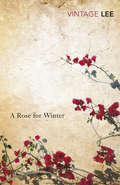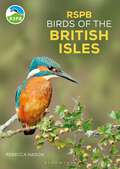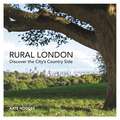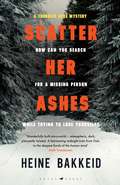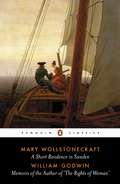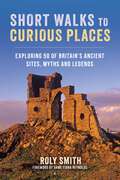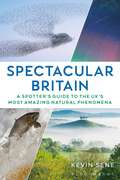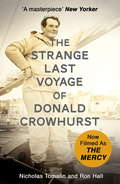- Table View
- List View
A Rose For Winter: Travels In Andalusia
by Laurie LeeAndalusia is a passion - and fifteen years after his last visit Laurie Lee returned. He found a country broken by the Civil War, but the totems of indestructible Spain survive: the Christ in agony, the thrilling flamenco cry-the pride in poverty, the gypsy intensity in vivid whitewashed slums, the cult of the bullfight, the exultation in death, the humour of hopelessness-the paradoxes deep in the fiery bones of Spain. Rich with kaleidoscopic images, A Rose for Winter is as sensual and evocative as the sun-scorched landscape of Andalusia itself.
RSPB Birds of the British Isles (RSPB)
by Rebecca NasonA pocket-friendly photographic field guide to 290 birds of the British Isles.RSPB Birds of the British Isles features all regularly occurring birds in Britain, Ireland and the Isle of Man, covering familiar year-round species such as Wren and Sparrowhawk, winter and summer visitors including Purple Sandpiper and Arctic Tern, and a selection of rarer birds.Featuring concise identification text and expert photography, this photographic reference guide is suitable for both beginner and experienced birdwatchers alike. Species accounts include succinct descriptions of each bird's appearance, behaviour, calls and songs, and seasonal movements. The guide also identifies where to see each species and showcases this clearly through up-to-date distribution maps of the British Isles. Author and photographer Rebecca Nason has carefully chosen over 500 colour photographs to illuminate key identification points, including photos of male and female birds for sexually dimorphic species.Whether you are birdwatching in your garden or exploring wetlands, woodlands, mountains or coastlines, RSPB Birds of the British Isles is an ideal companion.
Rural London: Discover the City's Country Side
by Kate HodgesLondon is a wonderful city, but sometimes the hustle and bustle, noise and grime, can get too much and you feel the need for some peace and quiet, clean air and nature. But there’s no need to flee to the countryside, as London has so many surprisingly ‘rural’ areas and activities to offer. With everything from beautiful gardens and country walks, to cosy pubs and nature reserves, Rural London will help you to discover a very unexpected side of the capital city. Discover the best farmers markets, watch some morris dancing and visit a country show. Take a stroll around London’s villages, go bird-spotting and take some time out in a beautiful park. With colour photographs, short descriptions setting the scene and visiting details for each entry, this guide to rural London provides plenty of ideas and inspiration for places to visit and things to do, with something here for everyone.
Saturn V Rocket (Large Print)
This is an image of the Saturn V rocket: the type that carried American astronauts on the various Apollo missions to the moon in the 1960s and '70s. There is a locator dot shown, which will be at the top left of the page when the image is the right way up. The rocket is seen from the side moving diagonally from the bottom left of the page to the top right. It was 354 feet (108 metres) high and consisted of four stages, the last of which landed on the moon. At the bottom left of the page are the first stage rocket engine's exhaust gases pushing the vehicle through the atmosphere. Up and right from this are three of the five first stage engine outlets. Moving up and to the right are the rest of the rocket stages; they are marked by lines across the width of the launch vehicle. The fine textured section at the top right of the page is the spacecraft. This carried the astronauts and the lunar module, which travelled to and landed on the moon. The pointed section at the very top was the LES (launch escape system)
Saturn V Rocket (UEB Contracted)
This is an image of the Saturn V rocket: the type that carried American astronauts on the various Apollo missions to the moon in the 1960s and '70s. There is a locator dot shown, which will be at the top left of the page when the image is the right way up. The rocket is seen from the side moving diagonally from the bottom left of the page to the top right. It was 354 feet (108 metres) high and consisted of four stages, the last of which landed on the moon. At the bottom left of the page are the first stage rocket engine's exhaust gases pushing the vehicle through the atmosphere. Up and right from this are three of the five first stage engine outlets. Moving up and to the right are the rest of the rocket stages; they are marked by lines across the width of the launch vehicle. The fine textured section at the top right of the page is the spacecraft. This carried the astronauts and the lunar module, which travelled to and landed on the moon. The pointed section at the very top was the LES (launch escape system)
Saturn V Rocket (UEB Uncontracted)
This is an image of the Saturn V rocket: the type that carried American astronauts on the various Apollo missions to the moon in the 1960s and '70s. There is a locator dot shown, which will be at the top left of the page when the image is the right way up. The rocket is seen from the side moving diagonally from the bottom left of the page to the top right. It was 354 feet (108 metres) high and consisted of four stages, the last of which landed on the moon. At the bottom left of the page are the first stage rocket engine's exhaust gases pushing the vehicle through the atmosphere. Up and right from this are three of the five first stage engine outlets. Moving up and to the right are the rest of the rocket stages; they are marked by lines across the width of the launch vehicle. The fine textured section at the top right of the page is the spacecraft. This carried the astronauts and the lunar module, which travelled to and landed on the moon. The pointed section at the very top was the LES (launch escape system)
Scatter Her Ashes (A Thorkild Aske Mystery)
by Heine BakkeidCreepy, atmospheric and darkly comic – C. J. TudorBakkeid is already big and his work is only going to get bigger and better – Daily RecordDisgraced, damaged former police officer Thorkild Aske has stopped taking his painkillers after his last experience searching for the missing in northern Norway. Wracked by withdrawal and desperate for work, he reluctantly agrees to investigate the disappearance of two schoolgirls for bestselling crime writer Milla Lind – but he soon discovers that Lind's interest in the case is not, as she claims, simply research for her latest novel.When Thorkild discovers that her previous investigator was murdered on the job, no-one will explain why – all he has to go on are files about unrelated cases from all across Norway. Oh, and his ex-wife wants to talk. What could possibly go wrong?Praise for the Thorkild Aske series:'Stephen King has got himself a Norwegian crime heir' - Ekstra Bladet'Wonderfully creepy' - Daily Mail'A gripping, atmospheric novel and a first outing for Aske. More are promised – I can't wait' - Saga'At a stroke, Bakkeid has entered the upper echelons of Norwegian crime writing' - Barry Forshaw
A Short Residence in Sweden & Memoirs of the Author of 'The Rights of Woman' (The\regency Library)
by Mary Wollstonecraft William Godwin Richard HolmesIn these two closely linked works - a travel book and a biography of its author - we witness a moving encounter between two of the most daring and original minds of the late eighteenth century: A Short Residence in Sweden is the record of Wollstonecraft's last journey in search of happiness, into the remote and beautiful backwoods of Scandinavia. The quest for a lost treasure ship, the pain of a wrecked love affair, memories of the French Revolution, and the longing for some Golden Age, all shape this vivid narrative, which Richard Holmes argues is one of the neglected masterpieces of early English Romanticism.Memoirs is Godwin's own account of Wollstonecraft's life, written with passionate intensity a few weeks after her tragic death. Casting aside literary convention, Godwin creates an intimate portrait of his wife, startling in its candour and psychological truth. Received with outrage by friends and critics alike, and virtually suppressed for a century, it can now be recognized as one of the landmarks in the development of modern biography.
Short Walks to Curious Places: Exploring 50 of Britain's Ancient Sites, Myths and Legends
by Roly SmithEmbark on an extraordinary journey through the British countryside, leading to mysterious sites, ancient wonders and legendary landscapes to uncover 50 of the most intriguing walks in Britain. Discover the Green Chapel of Arthurian legend deep in the Staffordshire moorlands. Take a magical stroll through the fairytale forest of Wistman's Woods on Dartmoor. Marvel at the surreal rock formations of Brimham Rocks in Yorkshire, or spot the Hogwarts Express crossing the Glenfinnan Viaduct in the Scottish Highlands. With each walk ranging from two to eight miles in length and featuring beautiful photography, helpful directions and useful information, this book guarantees captivating experiences for walkers of all abilities, whether you're a casual stroller or seasoned hiker. Short Walks to Curious Places is your key to unlocking the secrets of the British countryside. With every step, you'll uncover the stories that shaped these extraordinary landscapes. Get ready to explore, discover and be enchanted by the wonders that lie just beyond the beaten path.
Space Shuttle (Large Print)
This is a diagram of an American space shuttle, designed to carry large loads in an orbital path around the circumference of the Earth. There is a locator dot shown, which will be at the top left of the page when the image is the right way up. The shuttle is shown in two views: a plan view (seen from above) and a side view. The shuttle is carried into the upper atmosphere of the earth by SRBs (solid rocket boosters) and then continues under the power of its own engines. The plan view is in the top left part of the page. The nose cone of the shuttle is at the far left. Directly right of this is the cockpit window, the main body of the craft with the payload doors, the engine covers, the rudder, and the engines. The swept-back wings of the shuttle extend up and down the page from the main body. To the far right of the plan view the expelled gasses that push the craft through space can be found. The side view of the shuttle is in the bottom right of the page. At the left of the image is the nose cone with a landing wheel just down the page. Moving right is the main body of the craft with the payload doors at the top and the wings and rear landing wheel down the page. Further to the right two of the four engines are visible with expelled gasses at the far right. Slightly up the page is the rudder.
Space Shuttle (UEB Contracted)
This is a diagram of an American space shuttle, designed to carry large loads in an orbital path around the circumference of the Earth. There is a locator dot shown, which will be at the top left of the page when the image is the right way up. The shuttle is shown in two views: a plan view (seen from above) and a side view. The shuttle is carried into the upper atmosphere of the earth by SRBs (solid rocket boosters) and then continues under the power of its own engines. The plan view is in the top left part of the page. The nose cone of the shuttle is at the far left. Directly right of this is the cockpit window, the main body of the craft with the payload doors, the engine covers, the rudder, and the engines. The swept-back wings of the shuttle extend up and down the page from the main body. To the far right of the plan view the expelled gasses that push the craft through space can be found. The side view of the shuttle is in the bottom right of the page. At the left of the image is the nose cone with a landing wheel just down the page. Moving right is the main body of the craft with the payload doors at the top and the wings and rear landing wheel down the page. Further to the right two of the four engines are visible with expelled gasses at the far right. Slightly up the page is the rudder.
Space Shuttle (UEB Uncontracted)
This is a diagram of an American space shuttle, designed to carry large loads in an orbital path around the circumference of the Earth. There is a locator dot shown, which will be at the top left of the page when the image is the right way up. The shuttle is shown in two views: a plan view (seen from above) and a side view. The shuttle is carried into the upper atmosphere of the earth by SRBs (solid rocket boosters) and then continues under the power of its own engines. The plan view is in the top left part of the page. The nose cone of the shuttle is at the far left. Directly right of this is the cockpit window, the main body of the craft with the payload doors, the engine covers, the rudder, and the engines. The swept-back wings of the shuttle extend up and down the page from the main body. To the far right of the plan view the expelled gasses that push the craft through space can be found. The side view of the shuttle is in the bottom right of the page. At the left of the image is the nose cone with a landing wheel just down the page. Moving right is the main body of the craft with the payload doors at the top and the wings and rear landing wheel down the page. Further to the right two of the four engines are visible with expelled gasses at the far right. Slightly up the page is the rudder.
SpaceShipOne (Large Print)
This page shows an image of SpaceShipOne, designed to be the first non-government funded craft to reach the edge of space at just over one hundred kilometres. It was launched from a purpose-built aircraft, White Knight. There is a locator dot shown, which will be at the top left of the page when the image is the right way up. At the top centre of the page is the nose cone of the craft with many small round windows shown in a heavy texture. Down the page is the body of the plane and down again is the nozzle of the engine and the hot gases being expelled towards the bottom of the page. To the left and right of the body are the two wings. They are hinged so that their configuration can be changed for the climbing, gliding, and re-entry stages of flight.
SpaceShipOne (UEB Contracted)
This page shows an image of SpaceShipOne, designed to be the first non-government funded craft to reach the edge of space at just over one hundred kilometres. It was launched from a purpose-built aircraft, White Knight. There is a locator dot shown, which will be at the top left of the page when the image is the right way up. At the top centre of the page is the nose cone of the craft with many small round windows shown in a heavy texture. Down the page is the body of the plane and down again is the nozzle of the engine and the hot gases being expelled towards the bottom of the page. To the left and right of the body are the two wings. They are hinged so that their configuration can be changed for the climbing, gliding, and re-entry stages of flight.
SpaceShipOne (UEB Uncontracted)
This page shows an image of SpaceShipOne, designed to be the first non-government funded craft to reach the edge of space at just over one hundred kilometres. It was launched from a purpose-built aircraft, White Knight. There is a locator dot shown, which will be at the top left of the page when the image is the right way up. At the top centre of the page is the nose cone of the craft with many small round windows shown in a heavy texture. Down the page is the body of the plane and down again is the nozzle of the engine and the hot gases being expelled towards the bottom of the page. To the left and right of the body are the two wings. They are hinged so that their configuration can be changed for the climbing, gliding, and re-entry stages of flight.
Spectacular Britain: A spotter's guide to the UK’s most amazing natural phenomena
by Kevin SeneFrom the Northern Lights to whirling coastal birds, and sunken villages to the annual deer rut, the UK is home to some of the world's finest natural spectacles. With this guide and a little luck, you too can experience the magic of seeing something truly extraordinary.Start planning your spectacular year with the help of this practical guide to the UK's most magical natural phenomena. This guide shows you when and where to go, and how to maximise your chances of a sighting, as well as explaining why these amazing spectacles occur in the first place. Sections cover: - Space: meteor showers, eclipses and supermoons, Northern Lights - Weather: hidden currents, mountain waves, named winds - Tides: tidal bores, tidal races, low tide walks - Land: autumn colours, wildflower displays, rutting deer - Rivers and lakes: salmon runs, sunken villages, waterfall wonders - Coast: wheeling waterbirds, seabird cities, seal pupsEach spectacle is graded according to how easy it is to spot, and the author gives expert tips on achieving the best sighting. Scientific insights describe the astronomical, meteorological and ecological causes of events, which are brought to life through the stories of the people who know them best, from the glider pilots who ride mountain waves to the King's Guides who help people navigate the dangerous sands of Morecombe Bay. This is your starting point for some truly phenomenal adventures.
The Strange Last Voyage of Donald Crowhurst: Now Filmed As The Mercy (Sailmate Ser.)
by Ron Hall Nicholas Tomalin'A masterpiece.' New Yorker'Wholly riveting, brilliantly researched.' Evening Standard'A meticulous investigation into the seeds of disaster... fascinating, uncomfortable reading.' Sunday Times In 1968, Donald Crowhurst was trying to market a nautical navigation device he had developed, and saw the Sunday Times Golden Globe round the world sailing race as the perfect opportunity to showcase his product. Few people knew that he wasn't an experienced deep-water sailor. His progress was so slow that he decided to short-cut the journey, while falsifying his location through radio messages from his supposed course.Everyone following the race thought that he was winning, and a hero's welcome awaited him at home in Britain. But on 10 July 1968, eight months after he set off, his wife was told that his boat had been discovered drifting in mid-Atlantic. Crowhurst was missing, assumed drowned, and there was much speculation that this was one of the great mysteries of the sea. In this masterpiece of investigative journalism, Nicholas Tomalin and Ron Hall reconstruct one of the greatest hoaxes of our time. From in-depth interviews with Crowhurst's family and friends and telling excerpts from his logbooks, Tomalin and Hall develop a tale of tragic self-delusion and public deception, a haunting portrait of a complex, deeply troubled man and his journey into the heart of darkness.
